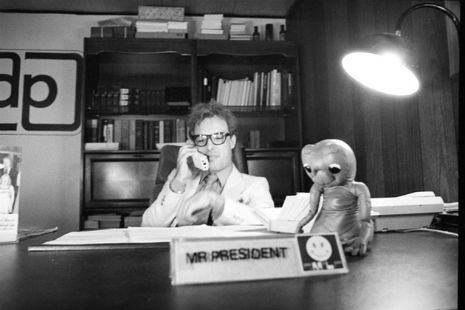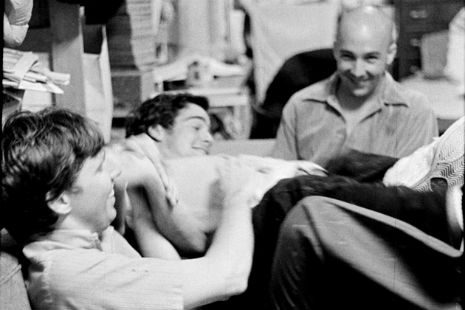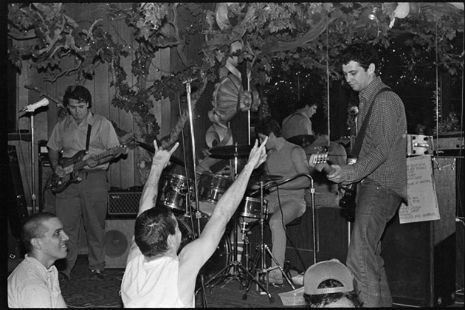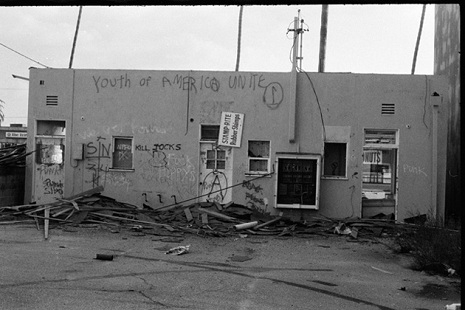
Jello Biafra as the president of the United States in Lovedolls Superstar, occupying an empty office adjacent to SST/Global, 1985. Photograph by Jordan Schwartz
After the recent release of We Got Power!: Hardcore Punk Scenes from 1980s Southern California, a compendium of the landmark 1980s ‘zine, co-creator David Markey answered a few questions for Amber Frost. (You can read my previous review here.)
AF: How did you go about compiling the essays (and essayists) for the book? I’m sure people have spread out quite a bit since the 80s.
Markey: By simply looking at the subjects in the photos, thankfully we were in touch with a lot of them. A few had moved to far away lands, some remained close friends; people that we’ve worked with on various projects over the years. Facebook came in handy with tracking a couple of them down.
AF: When you first started We Got Power! Did you have a concept that you were documenting a movement at the time?
Markey: We were definitely inspired by what was going down. 1981 was just one of those years, there was a collective energy going on. It was an incredibly dense time for music and bands in Southern California. Looking back on it, it was actually a very eclectic scene. It just wasn’t one kind of music really, but it all came together out of a necessity. Whether you were Fear or the Suburban Lawns; The Descendents or The Gun Club.
AF: There’s a bit in the Cameron Jaime essay that really stuck with me:
We all know about the nihilistic violence and rage the kids felt against their parents, schools, cops, and society at large. But I’m surprised at how rarely popular culture and humor are discussed as a major drive in the development of hardcore punk attitudes and aesthetics
I remember realizing as a punk (right around the 2000s), I wouldn’t have reduced my identity to “rage”, but that others did. Do you think there was a cognitive dissonance between how the kids identified themselves at the time and how music history has come to perceive them?
Markey: You have to go back and look at the environment of the early eighties in Los Angeles. At the time, you were fighting the tide by being into this music and scene. You were asking for trouble in a way, even if that was not necessarily your intent.
Many were threatened by this music. The local media went out of their way to paint this scene as violent and destructive. This lead to the now infamous anti-punk episodes of the popular TV shows “Chips” and “Quincy.”
Daryl Gates’ LAPD too had it in big time for the punks, and also the Baby Boomers who had a stranglehold on the music business at the time. Not only that but rednecks in Cameros, who seemed to enjoy yelling “Devo” at us.
I think maybe we saw all this and decided that humor was the great equalizer. I think it’s better to get someone to laugh and hopefully that will lead to some sort of enlightenment, rather than beat someone over the head with some heavy handed political agenda.

Left to Right, Greg Ginn, Henry Rollins, and Chuck Dukowski of Black Flag, SST Phelan office, on Phelan St. in Redondo Beach. Photograph by David Markey.
AF: “Punk is dead” has been bandied about forever. What do you think when reviews of the book start out with lines like, “In 1979, punk was over . . . but by 1981, hardcore was born.”?
Markey: That line was actually penned first by our editor, Ian Christe. It was great working with him. I think his input to the project was invaluable. I actually considered it “Hardcore Punk”, as we were definitely informed by the Class of ‘77 which had already came and went. We were the next generation of LA Punk.
I think we were maybe trying to expand on what was considered “punk”. Which you know for many just was a style, a look. A Mohawk. A safety pin through the cheek. I think perhaps we were trying to go deeper than the surface, the cosmetic. We were trying to bring it into our lives in a more meaningful way. I wasn’t about wearing manufactured “Anarchy” T-shirts, but I understood how important “no rules” was, especially when there became a more strict definition within the scene itself.
AF: The aesthetic for We Got Power! Is a visual staple for ‘zines at this point- the collages, cartoons, type/image balance, etc- what were your visual inspirations at the time?
Markey: I had done Xerox publications prior to this as a kid with a neighborhood newspaper. I used an electric typewriter and Letra-set rub-off letters. I also think this is where the mazes and word puzzle games were coming from. As a kid I was really into Mad Magazine and early Saturday Night Live. I loved movies like Harold and Maude and Kentucky Fried Movie.
AF: There’s an editorial in the first issue that ends with “Yes, it is true, people with long hair can share the “punk attitude”. The scene is reserved for no one. Everyone is eligible. Everyone counts”. Was “punk policing” much of an issue? Did the scene struggle with exclusivity?
Markey: I recall the first gig I went to, an X show at the Santa Monica Civic, and getting harassed for my hair length by a group of Huntington Beach Skinheads. Jennifer (Jordan’s sister and also a collaborator on the ‘zine) got a big wad of gum in her hair at a Starwood Tuesday night punk show. There were all sorts of punk politics going on at the time. Some of which were ridiculous and hypocritical. I think we did our best to diffuse this.
AF: A lot is made of the political context of hardcore, and while bands like The Dead Kennedys were explicitly political, a lot more were implicit. Do you think the scene as a whole had a political consciousness?
Markey: There were overtly political bands but lot of it was about personal politics, like how much someone’s dad sucked, or how lousy it was to be hit in the head with a LAPD baton. I recall at the time people being pretty cynical to all the Anti-Reagan material that was proliferating. But easy-targets aside, I’d say Reagan made Hardcore possible. There was a lot of humor as well.

The Minutemen, Grandia Room, Hollywood, CA, 1982. Photograph by Jordan Schwartz.
AF: What do you think of the trajectory of DIY culture since the 80’s?
Markey: I guess it went from some kid in a bedroom working on a fanzine or some hardcore band’s cover art, to some graphic artist who maybe grew up admiring that aesthetic, who took the idea and turned it into a Nike Ad.
I was DIY before I ever heard the phrase being bandied about. For me it was a necessity. There was just no other way for this stuff to happen. No one else was going to do this work for you. And the key thing for me was, it did not seem like work at all. It seemed like fun.
AF: What did you anticipate the punk developing into at the time? How do you think that compares to what it has become?
Markey: I just loved the music, and I watched it spread nationally through fanzine culture and various independent record labels, many founded by bands themselves. Then the nineties kicked in, and that showed the direct influence of the American 1980’s underground within the mainstream.
I am not sure if any of us as teenagers had any sort of long term vision of where this would all go. It just sort of went through the changes that it went through. We may have joked about it. But the good thing was many of these previously under heard and unappreciated bands had the attention of more people than ever. There is always time for rebellion and kids carving out their own way of doing things. In fact, it’s needed now more than ever. I can only hope this will inspire.
Thanks David, for talking with us, and thanks to Bazillions Points Books for facilitating this and putting out We Got Power!. I can’t possibly recommend it enough for anyone interested in the history and trajectory of punk and DIY.

“Youth of America Unite! The rear of the Punk Shack during demolition. Local anti-punk surfers crossed out our Black Flag graffiti as part of an ongoing war. A year or two later, these same culprits would cut their long surfer hair and don Suicidal Tendencies shirts.” Photograph by David Markey





